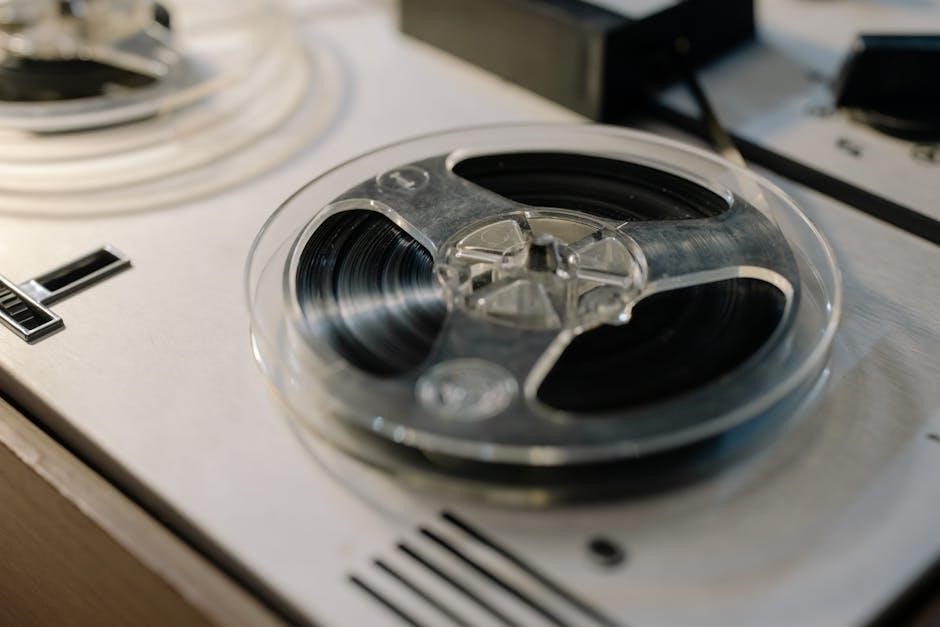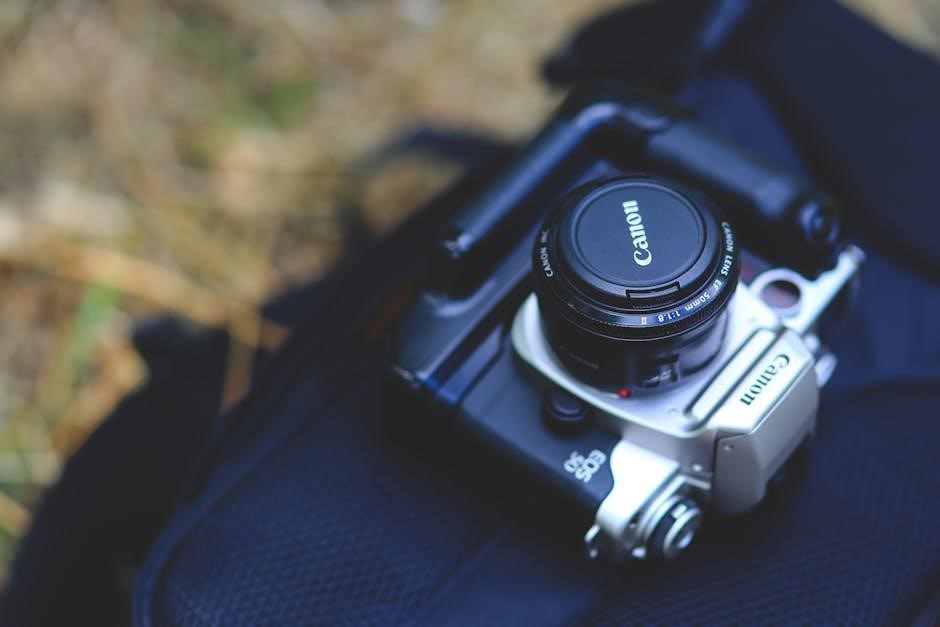The Canon EOS 7D is a high-performance DSLR camera featuring an 18.0-megapixel CMOS sensor, dual DIGIC 4 processors, and full HD video recording capabilities, designed for professionals and enthusiasts seeking advanced imaging solutions. The EOS 7D manual provides comprehensive guidance on camera operations, settings, and troubleshooting, ensuring optimal performance for photographers of all skill levels;
1.1 Key Features of the Canon EOS 7D
The Canon EOS 7D boasts an 18.0-megapixel APS-C CMOS sensor, delivering high-resolution images with excellent detail. It features dual DIGIC 4 image processors, enabling fast performance and efficient noise reduction. The camera supports full HD video recording at 1080p and offers manual controls for enhanced creativity. With 19 cross-type AF points, it ensures precise autofocus even in challenging conditions. The EOS 7D also includes an 8fps continuous shooting mode, ideal for capturing action sequences. Its weather-sealed design provides durability, and the 3-inch LCD screen offers clear image review and menu navigation.
1.2 Target Audience for the Canon EOS 7D
The Canon EOS 7D is designed for professional photographers and advanced enthusiasts seeking high performance and control. It appeals to those requiring fast autofocus, high-speed continuous shooting, and superior image quality. The camera is ideal for sports, wildlife, and action photography due to its 8fps burst mode and 19 cross-type AF points. Hobbyists with intermediate to advanced photography skills also benefit from its manual controls and customizable settings. The EOS 7D manual caters to users needing detailed guidance to maximize the camera’s capabilities, ensuring optimal results across various shooting scenarios.

System Requirements for Canon EOS 7D
The Canon EOS 7D requires compatible operating systems and software for optimal functionality. Ensure your system meets these requirements to download images and update firmware seamlessly.
2.1 Compatible Operating Systems
The Canon EOS 7D is compatible with various operating systems, including Windows 10, Windows 8.1, Windows 7, and macOS versions like macOS Mojave, High Sierra, and Sierra. Ensure your OS is updated to the latest version for optimal performance. Compatibility with older systems may vary, so check Canon’s official website for detailed specifications. Proper OS compatibility ensures smooth camera functionality, firmware updates, and software interactions, such as image transfers and editing.
2.2 Software Requirements for Operation
The Canon EOS 7D requires compatible software for optimal functionality. Use Adobe Reader 6.0 or later to view the PDF manual. The EOS Utility and Digital Photo Professional are essential for camera control and image editing. Ensure you install the latest versions of these programs from the Canon website. Additionally, the EOS Solution Disk provides necessary drivers and software. Always update your software to maintain compatibility and performance. For troubleshooting and updates, refer to the official Canon support page to download the latest firmware and tools.

Unpacking and Accessories
The Canon EOS 7D comes with a detailed manual, battery, charger, and essential accessories, ensuring optimal initial setup and functionality for photographers.
3.1 What’s Included in the Box
The Canon EOS 7D box includes the camera body, a rechargeable lithium-ion battery (LP-E6), battery charger (LC-E6), neck strap, USB cable, AV cable, and an instruction manual. Additional accessories like lenses, memory cards, and external flashes must be purchased separately. The manual provides detailed setup instructions and troubleshooting tips, ensuring users can fully utilize the camera’s features. Optional accessories, such as remote controls or cases, can enhance functionality and protection for the device.
3.2 First-Time Setup and Initialization
Insert the provided battery into the Canon EOS 7D, ensuring it is fully charged using the LC-E6 charger. Attach the neck strap for secure handling. Install a compatible memory card, formatting it in the camera for optimal performance. Power on the camera and follow the on-screen prompts to set the date, time, and language. Refer to the instruction manual for guidance on initial firmware checks and updates. Complete the quick setup guide within the manual to customize settings according to your preferences, ensuring the camera is ready for use.

Camera Layout and Controls
The Canon EOS 7D features a mode dial, AF-ON button, and quick control dial for intuitive operation. The ergonomic design includes a rear LCD screen, navigation buttons, and customizable controls for seamless functionality.
4.1 Front View of the Canon EOS 7D
The front of the Canon EOS 7D features the lens mount, compatible with EF and EF-S lenses, and a depth-of-field preview button. The shutter release button is located on the top front, alongside the mode dial for selecting shooting modes. The handgrip is ergonomically designed for comfort, with the AF-ON button and joystick nearby for intuitive control. The front also includes a remote sensor for wireless remote shutter release and a self-timer lamp. These controls provide quick access to key functions, enhancing shooting efficiency and creativity for photographers of all levels.
4.2 Top View and Controls
The top of the Canon EOS 7D features a mode dial for selecting shooting modes, such as Manual, Aperture Priority, and Program AE. The shutter release button is centrally located, with the ISO sensitivity button nearby for quick adjustments; A metering mode button allows switching between Evaluative, Center-Weighted, and Spot metering. The power switch is positioned on the top right, ensuring easy access. A hot shoe is available for attaching external flash units, and the top LCD panel displays key settings like shutter speed, aperture, and ISO. These controls are ergonomically arranged to enhance shooting efficiency and customization, catering to both professionals and enthusiasts.
4.3 Rear View and Button Layout
The rear of the Canon EOS 7D features a 3-inch LCD screen for image preview and menu navigation. Below it, the Quick Control Dial simplifies browsing through settings. The Live View and Movie shooting buttons are positioned for easy access. Playback and erase buttons are located above the LCD, while the menu button opens the main menu system. The rear also includes buttons for adjusting AF modes, metering, and drive modes. These controls are intuitively arranged to streamline workflow, allowing photographers to make adjustments quickly without diverting attention from their subjects.
4.4 Bottom and Side Ports
The Canon EOS 7D features a range of ports for enhanced connectivity and functionality. On the side, users will find HDMI output for connecting to external displays and a microphone jack for high-quality audio recording. The USB port allows for data transfer to computers and compatibility with Canon’s EOS Utility software. The remote control terminal supports wireless remote shooters. Additionally, the camera includes a PC terminal for studio flash synchronization. These ports are strategically positioned to ensure ease of access while maintaining the camera’s ergonomic design, catering to both professional and enthusiast photographers.

Navigating the Menu System
The Canon EOS 7D features an intuitive menu system with clear tabs for shooting, playback, and setup options. Users can navigate using the Quick Control Dial or Multi-controller, allowing easy access to customize settings, review images, and adjust camera functions efficiently.
5.1 Quick Control Screen
The Quick Control Screen on the Canon EOS 7D provides instant access to frequently used settings, streamlining your workflow. By pressing the Quick Control button, a simplified menu appears, allowing adjustments to ISO, autofocus modes, drive modes, and more. Use the Multi-controller to navigate and select options. This feature reduces the need to delve into deeper menu systems, enabling quick changes while maintaining focus on your subject. It’s particularly useful for capturing fleeting moments, offering a balance of convenience and control for photographers of all levels.
5.2 Main Menu Navigation
The Canon EOS 7D’s main menu is divided into tabs for easy navigation: Shooting, Playback, Setup, Custom Functions, and My Menu. Use the Multi-controller to scroll through tabs and select options. The Shooting tab adjusts settings like image quality and white balance, while Playback allows reviewing and editing photos. The Setup tab manages camera preferences, and Custom Functions enable advanced customization. My Menu lets you register frequently used settings for quick access. This intuitive system streamlines workflow, allowing photographers to focus on creativity while efficiently managing camera settings.

Setting Up the Camera
Configure the EOS 7D by navigating through its intuitive menu system. Set date, time, and language preferences, and customize shooting settings according to your needs for optimal performance.
6.1 Initial Setup and Configuration
Begin by unpacking and inspecting the Canon EOS 7D, ensuring all accessories like the battery, charger, and manual are included. Charge the battery fully before first use. Insert the battery into the camera and mount a compatible EF-S lens. Install a memory card, preferably a high-speed CF card, to store images. Power on the camera and navigate to the menu to set the date, time, and language. Familiarize yourself with basic settings like image quality and autofocus modes. Refer to the provided PDF manual for detailed guidance on initial configuration and troubleshooting common setup issues.
6.2 Date, Time, and Language Settings

Access the camera’s menu to configure the date, time, and language. Use the Quick Control Dial to navigate to the Setup menu. Select Date/Time and Language options. Set the correct date and time using the arrow keys, ensuring accuracy for proper file naming and sorting. Choose your preferred language from the available options. Save your settings to ensure they are retained. Accurate date and time settings are crucial for organizing images and maintaining consistency in your workflow. Refer to the manual for detailed steps on adjusting these settings if needed. Proper configuration ensures seamless operation and avoids potential issues during image transfers. Always verify settings after initial setup to maintain accuracy and functionality. These settings are essential for optimal camera performance and user experience, making it easier to manage your photography workflow effectively. By following these steps, you can customize the camera to your preferences and ensure all features function correctly. This setup process is straightforward and necessary for maximizing the camera’s capabilities. Always refer to the Canon EOS 7D instruction manual for additional guidance or troubleshooting. Properly configured settings enhance your overall photography experience and ensure your images are properly timestamped and organized. Adjusting these settings is a critical part of the initial setup process and should be done carefully to avoid errors. The date, time, and language settings are foundational for personalized camera operation, enabling you to work efficiently and effectively. By completing this step, you can move on to more advanced configurations, such as customizing shooting modes or image quality settings; This ensures your camera is tailored to your needs and preferences, providing a seamless and enjoyable shooting experience. Always ensure these settings are correct before capturing important moments to maintain accurate metadata and organization. The Canon EOS 7D’s intuitive menu system makes it easy to adjust these settings, even for first-time users. Familiarizing yourself with these options will help you make the most of your camera’s features and capabilities. Proper setup of date, time, and language is vital for maintaining consistency and accuracy in your photography workflow. This step is essential for ensuring your camera is ready for use and that all images are properly timestamped and organized. By carefully following the instructions in the manual, you can configure these settings quickly and efficiently, allowing you to focus on capturing stunning images. The Canon EOS 7D’s menu system is designed to be user-friendly, making it easy to navigate and adjust settings as needed. Always double-check your settings after initial configuration to ensure accuracy and avoid potential issues. This attention to detail will help you get the most out of your camera and enhance your overall photography experience. Properly setting the date, time, and language is a simple yet important step in mastering the Canon EOS 7D and unlocking its full potential. By completing this setup, you can ensure your camera is customized to your preferences and ready for use in various shooting scenarios. The manual provides clear instructions for adjusting these settings, making it easy for users of all skill levels to configure their camera accurately. This step is crucial for maintaining consistency in your photography workflow and ensuring your images are properly organized and timestamped. Always refer to the manual if you encounter any issues or need further clarification on these settings. The Canon EOS 7D’s date, time, and language settings are designed to be intuitive and user-friendly, allowing you to focus on what matters most – capturing high-quality images. By following the manual’s guidance, you can quickly and easily configure these settings and begin exploring the camera’s advanced features. Proper setup of date, time, and language ensures your camera is fully optimized for your needs, providing a solid foundation for your photography journey. This step is a key part of the initial setup process and should not be overlooked, as it directly impacts the organization and accuracy of your images. The Canon EOS 7D’s menu system is designed to streamline this process, making it easy to adjust settings and customize your camera experience. Always take the time to carefully configure these settings to ensure your camera performs at its best and your images are properly maintained. By doing so, you can fully utilize the camera’s capabilities and achieve professional-grade results in your photography. The date, time, and language settings are fundamental to the Canon EOS 7D’s operation, and proper configuration is essential for a seamless and enjoyable shooting experience. Refer to the manual for detailed instructions and troubleshooting tips to ensure your settings are accurate and functional. This step is a critical part of the setup process and will help you get the most out of your camera. Always verify these settings before capturing important images to maintain consistency and avoid errors. The Canon EOS 7D’s intuitive design makes it easy to adjust these settings, even for those new to DSLR cameras. By following the manual’s guidance, you can quickly configure the date, time, and language settings and begin exploring the camera’s advanced features. Proper setup of these settings is vital for organizing your images effectively and ensuring accurate metadata. This step is a key part of the initial configuration process and should be completed carefully to avoid any issues. The Canon EOS 7D’s menu system is user-friendly, allowing you to navigate and adjust settings with ease. Always double-check your settings after initial configuration to ensure everything is accurate and functioning properly. This attention to detail will help you make the most of your camera and enhance your overall photography experience. By carefully following the manual’s instructions, you can configure the date, time, and language settings quickly and efficiently, allowing you to focus on capturing stunning images. Proper setup of these settings is essential for maintaining consistency and accuracy in your photography workflow. The Canon EOS 7D’s intuitive menu system is designed to streamline this process, making it easy for users of all skill levels to configure their camera accurately. Always refer to the manual if you need further guidance or encounter any issues during setup. The date, time, and language settings are foundational to the camera’s operation, and proper configuration ensures your images are properly organized and timestamped. By completing this step, you can fully utilize the camera’s features and achieve professional-grade results in your photography. The Canon EOS 7D’s date, time, and language settings are designed to be easy to adjust, allowing you to customize your camera experience and ensure accurate image metadata. Always take the time to carefully configure these settings to get the most out of your camera. This step is a critical part of the setup process and will help you enjoy a seamless and enjoyable shooting experience. The manual provides clear instructions for adjusting these settings, making it easy for you to configure your camera accurately and efficiently. Proper setup of date, time, and language settings is vital for maintaining consistency in your photography workflow and ensuring your images are properly organized. By following the manual’s guidance, you can quickly and easily configure these settings and begin exploring the camera’s advanced features. The Canon EOS 7D’s intuitive design makes it easy to navigate and adjust settings, even for first-time users. Always double-check your settings after initial configuration to ensure accuracy and avoid potential issues. This attention to detail will help you make the most of your camera and enhance your overall photography experience. Properly setting the date, time, and language is a simple yet important step in mastering the Canon EOS 7D and unlocking its full potential. By completing this setup, you can ensure your camera is customized to your preferences and ready for use in various shooting scenarios. The manual provides clear instructions for adjusting these settings, making it easy for users of all skill levels to configure their camera accurately. This step is crucial for maintaining consistency in your photography workflow and ensuring your images are properly timestamped and organized. Always refer to the manual if you encounter any issues or need further clarification on these settings. The Canon EOS 7D’s date, time, and language settings are designed to be intuitive and user-friendly, allowing you to focus on what matters most – capturing high-quality images. By following the manual’s guidance, you can quickly and easily configure these settings and begin exploring the camera’s advanced features. Proper setup of date, time, and language ensures your camera is fully optimized for your needs, providing a solid foundation for your photography journey. This step is a key part of the initial setup process and should not be overlooked, as it directly impacts the organization and accuracy of your images. The Canon EOS 7D’s menu system is designed to streamline this process, making it easy to adjust settings and customize
6.3 Firmware Update Process
To update the Canon EOS 7D’s firmware, visit Canon’s official support website and download the latest firmware version compatible with your camera. Ensure you select the correct firmware file for your device to avoid errors. Use a memory card to transfer the firmware file to the camera. Insert the card, navigate to the camera’s menu, and select the firmware update option. Follow the on-screen instructions carefully to complete the update. Do not interrupt the process, as it may damage the camera. After the update, restart the camera to apply the changes; Regular firmware updates improve performance and add new features. Refer to the manual for detailed instructions and troubleshooting. Always use official Canon sources to ensure file authenticity and system compatibility. This process ensures your camera operates at its best with the latest enhancements and bug fixes. By following these steps, you can safely update your Canon EOS 7D and enjoy improved functionality. Properly updating firmware is essential for maintaining optimal camera performance and accessing new features. The process is designed to be user-friendly, but caution is advised to avoid potential issues. Always verify the firmware version and source before proceeding. The Canon EOS 7D’s firmware update process is straightforward when following the provided guidelines, ensuring your camera remains up-to-date and fully functional. This step is crucial for photographers seeking to maximize their camera’s capabilities and stay current with technological advancements. By updating the firmware, you can enhance your photography experience and take advantage of the latest features and improvements; The manual provides clear instructions to guide you through the process safely and effectively. Updating firmware is a recommended maintenance task to ensure your camera continues to perform at its highest level. The Canon EOS 7D’s firmware update process is a simple yet important step in maintaining your camera’s optimal performance and functionality. Always prioritize using official Canon firmware to protect your device and ensure compatibility. This process is essential for photographers who want to keep their camera up-to-date with the latest features and improvements. By following the manual’s instructions, you can confidently update your firmware and enjoy a seamless shooting experience. The firmware update process for the Canon EOS 7D is designed to be user-friendly, allowing you to enhance your camera’s capabilities without hassle. Regular updates are recommended to ensure your camera operates at its best and supports the latest technologies. The manual provides detailed guidance to help you complete the firmware update process successfully. This step is vital for maintaining your camera’s performance and ensuring it continues to meet your photography needs. The Canon EOS 7D’s firmware update process is a critical part of camera maintenance, enabling you to access new features and improvements. By following the instructions carefully, you can update your firmware with confidence and enjoy the benefits of the latest advancements in camera technology. The process is straightforward, but it’s important to follow the manual’s guidelines to avoid any potential issues. Updating your firmware ensures your Canon EOS 7D remains a powerful and reliable tool for capturing high-quality images. This step is essential for photographers who want to stay up-to-date with the latest features and enhancements. The firmware update process is designed to be safe and efficient when following the recommended steps. Always use official Canon sources to download firmware and refer to the manual for assistance if needed. By keeping your firmware updated, you can ensure your camera performs at its best and supports all its advanced features. The Canon EOS 7D’s firmware update process is a simple yet important task that helps you get the most out of your camera. Regular updates are necessary to maintain optimal performance and access new functionalities. The manual provides clear instructions to guide you through the process, making it easy to keep your camera up-to-date. This step is crucial for photographers who want to maximize their camera’s potential and enjoy a seamless shooting experience. By updating your firmware, you can ensure your Canon EOS 7D continues to deliver exceptional results and supports the latest advancements in photography. The firmware update process is a key part of camera maintenance and is designed to be user-friendly. Always follow the manual’s instructions to ensure a successful update and maintain your camera’s performance. This process is essential for keeping your Canon EOS 7D in optimal condition and unlocking its full potential. The firmware update process is a straightforward procedure that helps you stay current with the latest features and improvements. By following the manual’s guidance, you can update your firmware with confidence and enjoy enhanced camera functionality. This step is vital for photographers who want to keep their camera up-to-date and fully functional. The Canon EOS 7D’s firmware update process is designed to be safe and efficient, ensuring your camera remains a reliable tool for capturing stunning images. Always refer to the manual for detailed instructions and troubleshooting tips to ensure a smooth update process. By keeping your firmware updated, you can maximize your camera’s capabilities and enjoy a superior photography experience. The firmware update process is a critical part of maintaining your Canon EOS 7D and ensuring it continues to perform at its best. Regular updates are recommended to access new features and improvements. The manual provides clear guidance to help you complete the process successfully. This step is essential for photographers who want to stay up-to-date with the latest technologies and enhancements. By following the manual’s instructions, you can update your firmware with ease and confidence, ensuring your camera remains fully functional and optimized for your needs. The firmware update process is a simple yet important task that helps you get the most out of your Canon EOS 7D. Always use official Canon sources to download firmware and follow the manual’s guidelines to avoid potential issues. This process is crucial for maintaining your camera’s performance and ensuring it continues to deliver exceptional results. The Canon EOS 7D’s firmware update process is designed to be user-friendly, allowing you to enhance your camera’s capabilities without hassle. By keeping your firmware updated, you can enjoy the latest features and improvements, ensuring your camera remains a powerful tool for capturing high-quality images. The manual provides detailed instructions to guide you through the process, making it easy to stay current with the latest advancements. This step is essential for photographers who want to maximize their camera’s potential and enjoy a seamless shooting experience. The firmware update process is a key part of camera maintenance and is designed to be safe and efficient. Always follow the manual’s instructions to ensure a successful update and maintain your camera’s optimal performance. By updating your firmware, you can ensure your Canon EOS 7D continues to deliver outstanding results and supports the latest features and technologies. The firmware update process is a straightforward procedure that helps you keep your camera up-to-date and fully functional. The manual provides clear guidance to help you complete the process without issues. Regular firmware updates are necessary to maintain your camera’s performance and access new functionalities. By following the manual’s instructions, you can update your firmware with confidence and enjoy enhanced camera capabilities. The firmware update process is a critical step in maintaining your Canon EOS 7D and ensuring it continues to meet your photography needs. Always use official Canon sources to download firmware and refer to the manual for assistance if needed. This process is essential for photographers who want to stay current with the latest advancements and maximize their camera’s potential. The firmware update process is designed to be user-friendly and efficient, ensuring your camera remains a reliable and high-performing tool. By keeping your firmware updated, you can enjoy the latest features and improvements, ensuring your Canon EOS 7D continues to deliver exceptional results. The manual provides detailed instructions to guide you through the process, making it easy to keep your camera up-to-date. This step is crucial for photographers who want to get the most out of their camera and enjoy a seamless shooting experience. Regular firmware updates are necessary to maintain optimal performance and access new features. The firmware update process is a simple

Shooting Modes and Settings
The Canon EOS 7D offers various shooting modes, including Manual, Aperture Priority, Shutter Priority, and Program modes, allowing users to customize settings for optimal image capture.
7.1 Understanding Different Shooting Modes
The Canon EOS 7D offers a variety of shooting modes to cater to different photography needs. The Manual (M) mode allows full control over aperture and shutter speed for precise adjustments. Aperture Priority (Av) mode lets users set the aperture while the camera adjusts the shutter speed. Shutter Priority (Tv) mode enables control over shutter speed, ideal for capturing motion. Program (P) mode offers automatic settings with flexibility for minor adjustments. The Auto mode simplifies operation for beginners, while Bulb (B) mode allows long exposures for creative effects. Each mode provides unique capabilities, ensuring versatility for photographers.
7.2 Customizing Image Quality Settings
The Canon EOS 7D allows users to customize image quality settings to suit their preferences. Adjustments include selecting image size (Large, Medium, Small) and JPEG compression levels (Fine, Normal). For higher quality, RAW or RAW+JPEG formats can be chosen. Color space options like sRGB and Adobe RGB enable precise color reproduction. Picture Styles (Standard, Portrait, Landscape, etc.) offer preset enhancements for different subjects. Additionally, ISO sensitivity, white balance, and noise reduction can be fine-tuned for optimal results. These settings ensure images are captured with the desired aesthetic and technical quality, catering to both amateur and professional photographers.

Troubleshooting Common Issues

File Formats and Storage
The Canon EOS 7D supports JPEG, RAW, and RAW+JPEG file formats. Images are stored on CF memory cards, with two slots for flexible storage management and backup options.
